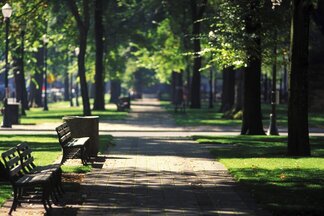 and this urban forester is here to remind you that even as we anticipate the brisk fall colors and temperatures, it's not too late to get started on your fall planting plan. Fall is a great time for planting, and one of my favorite times of year to be a forester and appreciate all the hard work so many community groups engage in to beautify our neighborhoods. Planting in the fall can give your trees a little extra time to reestablish their root systems before the rush of spring growth, but it's still important to keep watering in mind for the first couple years. Additional shout-out to black-gums this time of year - those red colors will be popping soon, and I swear they're worth the wait! When I left my urban forestry position with a city last spring, I was worried I'd miss all the special fall-planting moments . . . instead, I find we're preparing to help with multiple tree-plantings in the region, either with planting plans or in actual planting day volunteer assistance. What a privilege to be part of so many communities' tree stories, and truly help our region grow our canopy together! The City of Florence, Kentucky, helped us kick off our tree-planting season Do you have an underdog fall show-stopper to share? Questions about how we can help you focus more on canopy? Let me know! I'm excited to be the newest part of the Urban Canopy Works team and have the opportunity to help make the most of our forests! [email protected] Check out these tips for tree planting!  Urban Canopy Works co-founder, Rachel Comte, guests on the latest episode of the podcast, Healthy Living Healthy Planet. This weekly podcast features a variety of different experts each episode, and explores issues related to environmental issues and personal health, like climate change, plastic pollution, food justice and more. On this week's episode (episode 126, if you're reading this in the future), Rachel joins Mike Galvin, Director of SavATree Consulting Group and Neil Vora, physician at Conservation International for a discussion on trees in cities. Trees provide a host of benefits, including providing habitat for nature, serving as part of stormwater infrastructure, psychological benefits and more. How can we estimate the value of those benefits? What's the best way to regulate or preserve our natural spaces within the built environment? Listen here!  We enjoying seeing families gather around Christmas trees, dogs and cats sit under their branches (sometimes with some extra drama). Christmas is good public relations for trees because their scent, beauty, and majesty play a huge role in holiday memory-making. So, where did the Christmas Tree tradition begin and how did it become what it is today? Here is an historical timeline from the National Christmas Tree Association:
Lighting Tradition. According to the National Christmas Tree Association, lighted candles on Christmas Trees began in France in the 18th Century. However, others report that the origins are associated with Protestant Christian Reformer Martin Luther, who is said to have first added lighted candles to an evergreen tree in the 16th century. Thomas Edison's friend and partner in the Edison Illumination Company, Edward Johnson, is credited with putting together the first string of Christmas Tree lights in 1882. Lights were first mass-produced in 1890. In 1900, large stores began to light big Christmas Trees and in 1933, the tradition of the lighted tree in New York City’s Rockefeller Center began. Recycle Your Tree! Christmas Trees began to be sold commercially in the U.S. 1851. Today, approximately 25-30 million real Christmas Trees are sold in the U.S. each year! So it is a valuable thing for you to recycle your tree. Here are a few helpful tips from Earth 911 to guarantee your Christmas tree doesn’t end up in a landfill:
Whether you celebrate Christmas or not, we hope you enjoy the beauty and majesty of evergreen trees outdoors throughout the holiday season and beyond! Merry Christmas and Happy Holidays from Urban Canopy Works!  We work in urban forestry to help cities utiltize natural systems to create a healthier, vibrant place for their community to live. Freeing citizens up from city-living stresses means they are free to go do the work in the world they were meant to do! Trees alleviate so many urban challenges by the services they provide. Thanks to these benefits, more and more, trees are considered critical city infrastructure, and because they increase in value over time, they provide a return on investment. Here are 12 Reasons Trees are Essential for Healthy Communities
Are you surprised by #12? It’s true. Research has shown that the more tree cover surrounding a school, the better the test scores. A study of 450 middle schools and nearly 50,000 students in urban, suburban, and rural communities in Washington State was conducted by M. Kuo, associate professor in the Department of Natural Resources and Environmental Sciences at the University of Illinois. Kuo concluded that trees increase exposure to nature, helping to increase concentration and engagement, while also leading to less disruptive behavior. Since the urban forest is on both public and private land, cities should actively educate and engage citizens, businesses, and institutions in the value of the collective urban forest. “When everyone works together for positive outcomes, everyone wins,” says Urban Canopy Works co-owner Jenny Gulick. “I chose a career in Urban Forestry because I wanted to bring my passion for trees and forests to city and suburban dwellers. I’m most proud of the tens of thousands of trees I’ve planted. I can now go back to some of the first ones and see them arching over streets and front yards, totally transforming the neighborhoods.” This Thanksgiving, we invite you to join Urban Canopy Works in expressing gratitude for urban trees. Take a deep breath, take a walk on a tree-lined sidewalk or park, and take the opportunity to share the joy with family and friends. Learn more about the benefits of trees and why they’re essential for building healthy communities.  Urban Canopy Works (UCW) has received three prestigious awards. First, UCW's Columbus Urban Forest Master Plan, developed in 2020-21 has been given two awards:
Principal Jenny Gulick received the President’s Award from the Professional Grounds Management Society (PGMS). The President of PGMS presents an award to an individual or organization that has made significant contributions to PGMS or the grounds management profession. In this case, Jenny was awarded for doing both. She has been the PGMS Greater Cincinnati Branch President for over 15 years, participated on numerous PGMS committees, and most recently served two terms on the Board as a Director-At-Large. PGMS describes Jenney as “an engaged leader who is passionate about arboriculture as well as the green industry as a whole.” Over the course of Jenny’s career, she has provided leadership and technical guidance to a wide variety of national, regional, and local organizations, such as ISA, APWA, and the Kentucky Division of Forestry, to help promote urban forestry and elevate the people and programs that manage and protect our forest resources. Jenny says, “I’m pleased to receive this honor and am grateful for the opportunity to offer my experience and leadership to such a great organization.” Congratulations to Rachel and Jenny on receiving these awards! Urban Canopy Works is going to the Partners in Community Forestry Conference in Louisville, KY, November 17 and 18. Produced by the Arbor Day Foundation, this conference is the largest international gathering of urban forestry practitioners, advocates, researchers, and government leaders. People come together at this event to share best practices and get new ideas.
“We like helping people create and manage arboretums because they’re important,” says Urban Canopy Works (UCW) co-owner Jenny Gulick. “In addition to being beautiful places to visit and relax, arboretums promote the planting and protection of trees, and educate people about the importance of trees which all helps to create healthy, sustainable communities.”
Urban Canopy Works helps cities, senior living communities, businesses, and non-profits plan and prepare to become accredited arboretums, or to reach a higher level of accreditation. We do this by conducting tree inventories, preparing management plans, and training the people who will plant the trees and provide care. Accelerated by global warming, heat island effects are increasing as a result of the elimination of trees for city development. According to the Environmental Protection agency (EPA), when people are exposed to extreme heat, they can suffer from potentially deadly illnesses, such as heat exhaustion and heat stroke. Hot temperatures can also contribute to deaths from heart attacks, strokes, and other forms of cardiovascular disease. This is becoming apparent in vulnerable, underserved communities with low tree canopies and a lot of paved parking lots, roads, sidewalks, and roofs.
 Rachel Comte is pleased to be involved in the formation of the Women's Forest Congress! As a woman in forestry and a partner in a woman-owned business, she is excited for this opportunity to support other women in the industry, share information, and mentor (and encourage) the younger generation of women entering the industry. The Women’s Forest Congress is a newly formed network of women working and interested in all facets of forestry, with the initial goal of gathering in 2022 for an in-person Congress. The need for this organization has been made clear from the initial interest - the first gathering session last year (virtual, of course) attracted an impressive 600 women! Attendance at ongoing networking events remains strong. “I want to be a part of this because I believe in it,” says Rachel. “A woman’s perspective is important in an industry that typically attracts men. It allows us to think about forestry in new ways. My business partner Jenny Gulick and I are proud to be associated with this movement, with a commitment to paving the way for other women.” When Boston Mayor Martin J. Walsh told the Boston Herald that his city is moving forward with the creation of an urban forestry plan, he also announced the selection of Urban Canopy Works to lead the effort, together with Boston-based Stoss Landscape Urbanism. Mayor Walsh said, “Trees are an important part of making Boston’s communities resilient. This plan is the first of its kind in Boston, and it will expand and protect one of our most precious natural resources, while prioritizing the needs of our residents.” He added, “The 20-year plan will set citywide goals for canopy protection, be responsive to climate change and development, and enhance the quality of life for all Bostonians.”
|
|
Urban Canopy Works, LLC | Contact Us | © 2023-25
|
UCW is proud to support: |




